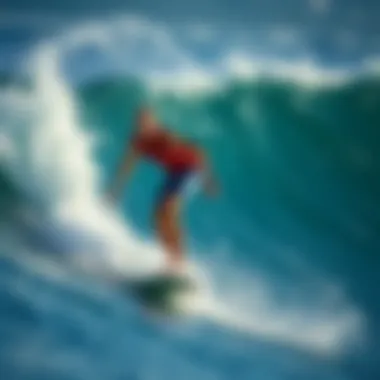Hydration Techniques for Surfers: Key Insights


Intro
Staying hydrated while surfing isn’t just a footnote in a performance guide; it’s a cornerstone of achieving peak performance on the waves. As any seasoned surfer knows, it’s not just about catching the biggest wave or honing that perfect turn. A surfer's ability to stay at the top of their game can hinge heavily on understanding their hydration levels.
Exploring how hydration intertwines with physical performance is like flipping over a tangled thread to find clarity. Too many surfers overlook this fundamental aspect of their practice. It's not merely about drinking water; it's about knowing when to hydrate, how much, and recognizing the signs of dehydration. In the unforgiving surf environment, a lack of awareness could mean the difference between riding the crest of the wave or wiping out from fatigue.
In this guide, we will delve into the various methods of assessing hydration, focusing particularly on techniques that can make a significant impact for surfers. From physical indicators to practical tests, this narrative will arm you with the knowledge to safeguard your hydration and enhance your overall surfing experience. Let's navigate through the waves of information and hit the beach prepped for success!
The Importance of Hydration in Surfing
When it comes to riding the waves, hydration is often an afterthought, yet it plays a crucial role in a surfer's performance and overall well-being. Surfers push their bodies to the limit, battling both the elements and their physical capabilities. Staying properly hydrated is essential for maintaining peak performance in such a demanding sport.
Physiological Impact of Dehydration
Surfers are no strangers to the scorching sun and salty sea. Dehydration can creep in unnoticed but can have significant consequences on the body’s ability to function efficiently.
Effects on stamina and endurance
Stamina and endurance are lifeblood to every surfer. When dehydration takes hold, it can lead to reduced energy levels. The key characteristic here is that even mild dehydration — as little as 2% loss in body weight — can compromise performance. Your body’s energy systems rely on adequate fluid intake for energy production. Without this, you might find yourself gasping for air after just a few waves.
A unique feature of understanding stamina in relation to hydration is its adaptability. You can train yourself to maintain endurance, but dehydration can quickly wipe those gains away, turning hours of hard work into a waste. This aspect makes hydration not just beneficial, but essential, particularly when you're spending long hours in the water.
Impacts on concentration and coordination
It's not just about muscle strength; concentration and coordination are equally vital while surfing. Dehydration can fog your cognitive functions and slow your reaction times, which can spell disaster in the unpredictable ocean. One moment of distraction can turn a thrilling ride into an unscheduled wipeout.
The notable point here is that coordination deteriorates with dehydration. Water influences brain function, and when you're not adequately hydrated, making swift decisions becomes that much harder. The unique disadvantage is that surfers, who often operate in high-stress environments, might not even be aware of their diminishing focus until it’s too late.
Hydration and Performance
Hydration directly connects to overall performance and a surfer’s ability to navigate challenges effectively.
Link between hydration and strength
Strength doesn’t just come from lifting weights but from being adequately hydrated. Water plays a role in nutrient transportation and muscle functionality. Hence, when discussing hydration and strength, the focus shifts to how hydration supports muscle recovery after strenuous activity. Those who are not properly hydrated will find their muscles tire more quickly and may even seize up.
The distinctive advantage of maintaining strength through hydration is that it gives the surfer a competitive edge. It’s easier to tackle bigger waves and longer sessions when you feel strong and spry.
Role in recovery and injury prevention
Post-surf recovery is paramount, and hydration is a cornerstone of that process. After you ride the adrenaline wave, replenishing lost fluids helps in the recovery of muscles and minimizes the risk of injuries. Staying hydrated supports joint lubrication and reduces cramps, which many surfers dread.
What makes this aspect notable is that injury prevention through hydration allows surfers to maintain their passion without mishaps sidelining them. It’s a protective layer you cannot afford to skip if you want to keep surfing for years to come.
Navigating through waves requires physical skill, but combining that with the knowledge of hydration empowers surfers to not only perform at their best but also stay safe while doing it. Ignoring the importance of hydration could lead to reduced stamina, impaired concentration, lesser strength, and increased risk of injury. Making hydration a priority is not just a smart choice; it’s an essential one for anyone who truly wants to master the waves.
Methods for Testing Hydration Levels


Understanding your hydration status is essential for any dedicated surfer. With the physical demands of paddling and catching waves, being aware of your hydration can mean the difference between an exhilarating session and a tiring struggle. This section explores various methods for testing hydration levels that surfers can use to ensure they're at their best in the surf.
Visual Indicators
Visual indicators are simple yet effective ways to gauge hydration levels. They can be easily observed without needing fancy tools or tests, making them particularly appealing for surfers on the go.
Color of urine as a hydration gauge
One of the quickest and most straightforward methods is to look at the color of your urine. A pale yellow indicates optimal hydration, while darker shades suggest dehydration. The beauty of this method lies in its ease; it's something that can be checked anytime, anywhere.
However, you should consider factors like diet and supplements which can alter urine color. For instance, foods such as beets or B vitamins can give a reddish tint, potentially misguiding your hydration assessment. While it's a useful gauge, context matters.
Skin elasticity and its implications
Another visual method involves skin elasticity. You can pinch the skin on the back of your hand and observe how quickly it returns to normal. Quick recovery suggests proper hydration, while sluggish return signals a potential deficit. This method, like others, has advantages and disadvantages. It’s easy to perform and requires no equipment, yet it may not be accurate for everyone, especially older surfers, where skin elasticity naturally decreases.
Physical Symptoms of Dehydration
Recognizing the physical signs of dehydration is critical, especially when you're out navigating the waves. These symptoms often serve as warning bells that should not be ignored.
Signs of fatigue and dizziness
Feeling unusually tired or dizzy can be a red flag. These symptoms are not just fatigue after a long surf; they could indicate you're running low on fluids. Surfers need to remain alert and focused, and any drop in concentration might hinder your performance. Keeping an eye on these signs is vital as they directly impact your ability to enjoy the sport to its fullest.
Muscle cramps as a warning sign
Muscle cramps are another telltale sign that your body might be craving water. They often arise when fluid levels are low, leading to imbalances in electrolytes. During surf sessions, the last thing you want is to battle cramping muscles while trying to catch a wave. Understanding this symptom can help surfers take immediate action, like hydrating to avoid down-the-line discomfort.
Measuring Body Weight Fluctuations
Tracking changes in body weight can offer insights into hydration levels, providing a practical, quantitative approach to self-assessment.
Establishing a baseline weight
To measure hydration through body weight, first, you need a baseline. Weigh yourself before and after a surf session to determine fluid loss. This method is beneficial as it provides clear data. However, it can be tricky if not done consistently. Stand on the same scale at the same time of day and under similar conditions to ensure your data is reliable.
Tracking changes during activity
Monitoring body weight fluctuations during surfing engagements allows insight into hydration needs in real-time. It helps in understanding what conditions—like temperature and the intensity of activity—might affect your hydration requirements. Despite its accuracy, this method unfortunately requires access to a scale, which might not always be feasible right after a surf session.
Advanced Hydration Testing Techniques
For surfers who want to take hydration assessment a step further, advanced techniques come into play. These methods can provide more detailed insights, though they are typically less accessible than visual methods.
Use of bioelectrical impedance
Bioelectrical impedance analysis (BIA) estimates body composition and hydration levels based on how electrical impulses move through the body. It's a slick way to assess hydration without invasive testing. While it's becoming more popular, not every surfer has access to this technology, which can make it less practical for routine use on the beach.
Urine specific gravity testing


Urine specific gravity testing assesses the concentration of solutes in urine, giving a comprehensive view of hydration. This test requires a specific device but can offer highly accurate results. However, the need for a proper setup can make it cumbersome for surfers who are already juggling gear while trying to catch the next wave.
In summary, while there are various techniques for evaluating hydration, integrating a mix of quick visual checks, awareness of physical signs, body weight tracking, and advanced tests could better equip surfers to maintain their peak performance. It’s about being proactive, knowing your body and responding accordingly to whatever the ocean throws your way.
Best Practices for Maintaining Hydration
Maintaining hydration is not just a good idea; it's vital for surfers who are often exposed to sun, salty water, and the physical exertions of riding waves. Proper hydration practices ensure better performance, reduce the risk of injury, and enhance recovery. Recognizing this, let's delve into a few best practices that can make a significant difference in hydration efforts while surfing.
Creating a Hydration Schedule
Creating a solid hydration schedule can serve as a game-changer for those serious about surfing. It’s good to keep a consistent flow of fluids rather than chugging a gallon before hopping onto the board. Timing of fluid intake plays an essential role here. Ideally, surfers should start hydrating well before they even set foot in the water—think of it like getting your car engine running before setting off on a long road trip.
Timing of fluid intake
Fluids should be consumed in small amounts regularly. Something like drinking a glass of water every hour leading up to an outing can keep hydration levels optimal. One important aspect to consider is that pre-hydration is crucial before hitting the waves; after all, not every sip has the same effect.
The unique feature of this approach is its capacity to gradually build internal reserves without overwhelming your stomach. It's a beneficial strategy, especially during the hotter, sunnier days when dehydration is quick to creep in.
Choosing the right beverages
Choosing the right beverages is another critical aspect. While plain water is essential, adding options like electrolyte drinks can work wonders too. They not only replenish lost fluids but also help in restoring electrolyte balance. This is important because, when you sweat, you lose both water and vital minerals.
The key characteristic of opting for an electrolyte solution is that it enhances absorption rates, helping you stay hydrated longer. On the flip side, some flavored drinks may have high sugar content, which isn’t great if consumed in large quantities. Balance is the name of the game here.
Nutrition’s Role in Hydration
Hydration isn’t just about fluids; nutrition has its part in the dance too. A well-rounded diet can provide necessary hydration support and help tone down overall fluid needs. This is about being smart with choices.
Foods with high water content
Vegetables and fruits packed with water content can help in maintaining hydration without the overwhelming intake of liquids. Any surfer can sip on watermelons or cucumbers as they are known to be around 90% water. Not only are they refreshing, but they also provide nutrients that support performance—talk about killing two birds with one stone.
What’s more, these foods are usually available in local markets or even at the beach. Their ease of access and hydrating properties make them a popular choice for anyone hitting the surf. But keep in mind, consuming only these won't replace the need for liquid intake; it's a complementary strategy.
Electrolyte balance considerations
Keeping an eye on electrolyte balance is another big piece of the puzzle. Sodium, potassium, magnesium—these aren’t just fancy names in chemistry; they're what help your body function effectively during physical activity. Ask any athlete, and they'll tell you how crucial it is during the summer heat or extended surfing sessions.
Incorporating electrolyte-rich drinks or snacks aids in bringing balance back into your system after sweating it out on the waves. The unique feature here is that it addresses the body’s specific needs during activity, ensuring you don't just hydrate but replenish strategically. On the downside, it’s essential not to overdo it, as too much sodium can lead to other complications.
Individual Variations in Hydration Needs
Understanding that hydration is not one-size-fits-all is crucial. Individual bodies, levels of exertion, and environmental factors all play a part in determining how much fluid one needs. It’s smart to tailor hydration efforts according to personal needs.
Factors affecting fluid requirements
Various factors impact fluid requirements, including age, weight, sweat rate, and even altitude. For instance, heavier surfers might require more fluids due to greater sweat loss. Understanding these factors helps in tailoring personal hydration strategies, and a little self-experimentation can lead to effective habits. The uniqueness of this personalization allows each surfer to find their sweet spot, driving better performance over time.


Adjusting based on surfing conditions
When it comes to adjusting based on surfing conditions, the mantra should be: be flexible. Hot, sunny days could demand more hydration, while cooler mornings might require less. So it’s essential to tune in and adjust fluid intake accordingly. The key characteristic of this practice is its adaptability based on the immediate environment and conditions. For example, harder paddling days could spotlight the need for increased hydration, while mellow sessions might lean toward holding back a bit.
This level of awareness can prevent dehydration and enhance overall surfing experiences. Plus, being responsive to changes keeps the body performing optimally.
Hydration Myths and Misconceptions
Hydration is more than just gulping down water. Misunderstandings about how hydration works can lead surfers to make poor choices, affecting both their performance and well-being. Clear knowledge about hydration myths will arm surfers with essential insights, ensuring they stay on top of their game when hitting the waves.
Debunking Common Myths
Misunderstandings about thirst
A prevalent myth is that once you feel thirsty, you're already dehydrated. This belief can be misleading. Thirst is merely a signal from your body that it needs water, but relying solely on it isn't a foolproof hydration strategy. The body can tolerate some dehydration without showing immediate signs. However, if you only drink when you're thirsty, you might not consume enough fluids to keep your performance steady throughout the day. It's better to take proactive measures, like sipping water regularly, depending on your activity level and weather conditions. For instance, if you know you're going to spend hours in the sun, it’s sensible to hydrate in advance, rather than waiting.
Proper hydration is not just about spots of water; it's an ongoing commitment.
Overhydration risks
Another misconception is that more is always better when it comes to drinking fluids. While staying hydrated is crucial, excessive fluid intake can lead to overhydration, or water intoxication, which disrupts your body's electrolyte balance. This condition can lead to nausea, headaches, and in severe cases, complications that may require emergency intervention. Understanding this balance is essential for surfers who push their limits. It is wise to listen to your body and not just stick to a simplistic rule like drink as much as you can.
The Role of Caffeine and Alcohol
Debating the diuretic effects
Caffeine is often scrutinized for its diuretic effects, leading many surfers to believe they should avoid it altogether. While it's true that caffeine can have a mild diuretic effect, the reality is a bit more nuanced. Regular consumers often build tolerance, and the overall impact on hydration may be negligible. Thus, for active individuals who enjoy a morning cup of coffee before surfing, it may not be as detrimental as once thought. However, moderation is key, as too much caffeine can still result in unwanted dehydration.
Situational usage considerations
When it comes to alcohol, it is pivotal to understand how situational factors influence hydration strategies. On one hand, a chill drink can be relaxing after a sunny surf session; on the other hand, alcohol acts as a diuretic and can lead to dehydration. Timing matters: enjoying a drink post-surf when the body can replenish fluids and electrolytes is different from slamming drinks before heading into the ocean. Knowledge of personal limits and how the body reacts to these substances can steer surfers towards safer choices while still enjoying their lifestyle.
Overall, recognizing hydration myths and misconceptions can profoundly shape how surfers prepare and recover. By debunking these myths, enthusiasts can ensure they maintain their health and enjoy the waves to the fullest.
Epilogue: The Path to Optimal Hydration
In every sport, hydration serves as a silent partner to performance, yet for surfers, it plays a critical role that can’t be overlooked. The ocean demands not only physical strength but also mental acuity. A proper hydration strategy can mean the difference between riding the wave of your life and struggling to paddle back to shore. Understanding the nuances of hydration is essential to enhance overall performance and enjoyment while surfing.
Summary of Key Points
To truly grasp the importance of hydration, let’s recap the pivotal insights shared in this article:
- Hydration’s Impact on Physiology: Dehydration can drastically influence stamina, concentration, and coordination. For surfers, these elements are critical in navigating waves effectively.
- Methods to Assess Hydration: Visual indicators, physical symptoms, and advanced testing techniques provide various ways to gauge hydration levels. These methods are not just theoretical; they are practical tools surfers can use daily.
- Best Practices for Staying Hydrated: Developing a hydration schedule tailored to individual needs, understanding nutritional contributions, and recognizing specific environmental factors are vital to maintaining optimal hydration.
- Myths and Misconceptions Debunked: It’s easy to fall prey to common myths, such as misinterpreting thirst or overlooking the effect of caffeine and alcohol. Clarity on these points can assist surfers in making informed decisions about their hydration.
Final Recommendations for Surfers
As you head into the surf or even prepare for a day at the beach, keep the following recommendations in mind:
- Stay Ahead with a Schedule: Set reminders to drink fluids regularly throughout the day, not just during surfing. It helps to create a habit.
- Hydrate Wisely: Opt for fluids that contribute to hydration. Electrolyte beverages, coconut water, and plain water can be excellent choices.
- Listen to Your Body: Pay attention to signs of dehydration. If you notice signs like fatigue, dizziness, or muscle cramps, take action immediately. Remember, the ocean will be waiting for you, but your body won’t tolerate neglect well.
- Tailor Hydration to Conditions: Every surfing session comes with different conditions. For example, a hot day requires more attention to hydration needs than a cooler, overcast one. Factor in your own sweat rate and exertion levels.
By channeling this knowledge into your surfing lifestyle, you will be equipped to ride the waves longer and more effectively while reducing the risks associated with dehydration. So, keep that water bottle handy and remember that every drop counts. Here’s to optimal hydration and the thrill of catching that perfect wave!
"Hydration is not just about replacing fluids; it's about supporting your body to perform at its best, especially when the surf is calling."
For further guidance, consider resources like the American Council on Exercise at acefitness.org or Mayo Clinic for detailed science-backed hydrating practices.



